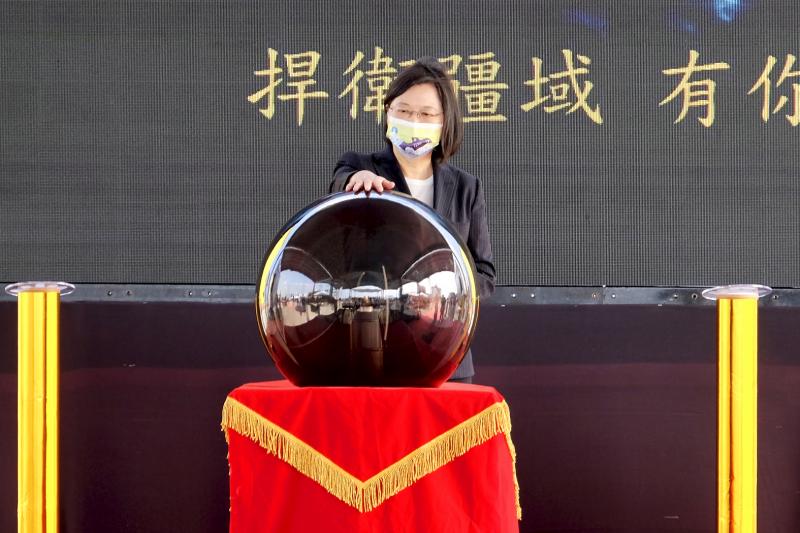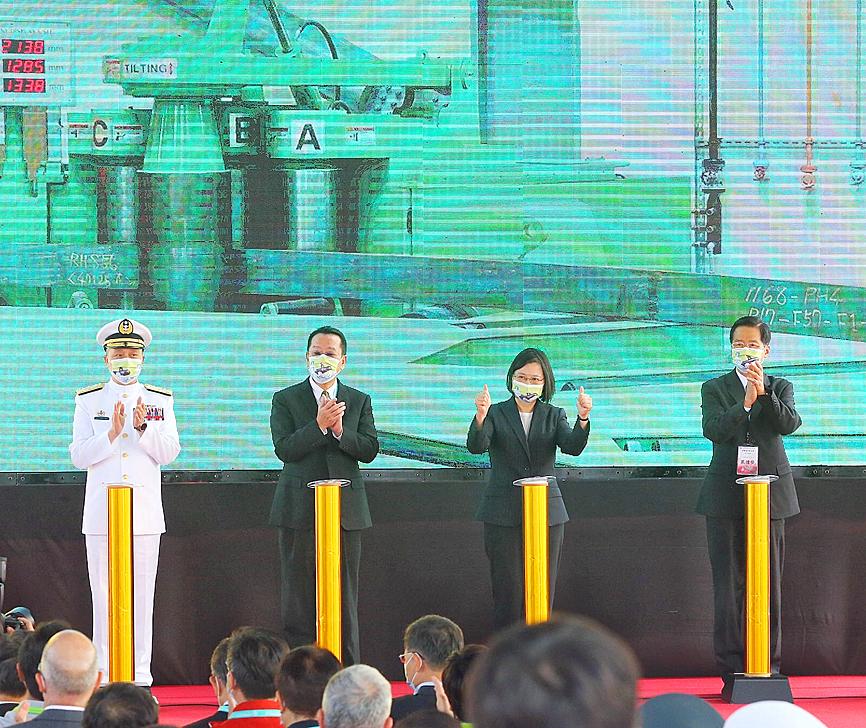President Tsai Ing-wen (蔡英文) yesterday presided over a ceremony to mark the start of construction of the nation’s first indigenous submarine at state-run shipbuilder CSBC Corp’s (台灣國際造船) shipyard in Kaohsiung.
“This submarine is an important part of allowing our navy to develop asymmetric warfare and to intimidate and block enemy ships from surrounding Taiwan’s main island,” Tsai said. “With the construction of the submarine to its future commission, we will certainly let the world know our persistence in safeguarding our sovereignty.”
Tsai has made boosting the nation’s indigenous defense capacity a central pillar of her defense policy. She recently relaunched the military aviation industry with the production of new trainer jets and has pushed for the development of more sophisticated systems by utilizing the domestic high-tech industries.

Photo: Wu Huizhong, AP
At the same time, she has gained approval from the US for the purchase of billions of US dollars in weapons, including upgraded F-16 jets, armed drones, rocket systems and Harpoon missiles capable of hitting ships and land targets.
China has stepped up military exercises toward Taiwan this year, flying fighter jets and reconnaissance planes on an almost daily basis toward the nation.
Taiwan turned to the expensive and time-consuming task of building its own submarines after Beijing prevented it from purchasing such craft from abroad through the use of economic and diplomatic threats.

Photo: CNA
Only a handful of countries around the world are capable of manufacturing submarines for modern warfare and Taiwan’s move toward that step has taken years. The Taiwanese submarine’s designs have reportedly drawn on foreign expertise, despite the obstacles thrown up by China.
CSBC was awarded the contract to design and build the subs in 2016, in partnership with arms developer the Chungshan Institute of Science and Technology.
Plans call for the building of eight indigenous submarines at an estimated cost of more than US$16 billion, with the first one to be completed by 2025.
The program, known as the Haichang Project (海昌計劃), has already faced criticism over its cost. The design phase itself was estimated to cost about NT$3 billion (US$104 million).
The submarine has been in the design stage for four years, overcoming all sorts of difficulties that could not be revealed to the public, CSBC chairman Cheng Wen-lon (鄭文隆) said yesterday.
The project is staffed by a team of about 200 technicians with an average age of only 34, making them “major assets” to the future of the domestic defense industry, he said.
Tsai conceded that the program was a struggle, but said her government would not be deterred.
“Walking on this path that historically the government has never taken before, there were all kinds of challenges, and we were met with all sorts of doubts, but challenges and doubts won’t defeat us,” Tsai said, standing in front of the workshop where the submarine parts are to be manufactured.
Minister of National Defense Yen De-fa (嚴德發), National Security Adviser Wellington Koo (顧立雄), American Institute in Taiwan Director Brent Christensen, legislators and members of the design team attended the ceremony.
Although Washington has no formal relations with Taipei, it remains Taiwan’s main ally, and US law requires the government to ensure that Taiwan can defend itself.
Weapons sales to Taiwan have increased in quantity and quality in the past few years, especially under US President Donald Trump’s administration.
Facing a potential Chinese foe with overwhelming superiority in missiles, soldiers, ships and planes, Taiwan has struggled to assure its own people, as well as the US, that it is capable of and willing to defend itself.
Along with the world’s largest standing military, numbering about 2 million members, China has the largest navy, with approximately 350 vessels, including two aircraft carriers and about 56 submarines.
It also possesses about 2,000 combat fighters and bombers and 1,250 ground-launched ballistic missiles, considered a key strategic and psychological weapon against Taiwan.
Taiwan’s armed forces are a fraction of that number, with much of its ground force consisting of short-term conscripts, and its fleet numbers only about 86 vessels, about half of them missile boats for coastal patrol.
The navy has just two combat-ready submarines, versions of the Zwaardvis-class subs purchased from the Netherlands in the 1980s in a deal that led to a major diplomatic rift between Bejing and The Hague.

A car bomb killed a senior Russian general in southern Moscow yesterday morning, the latest high-profile army figure to be blown up in a blast that came just hours after Russian and Ukrainian delegates held separate talks in Miami on a plan to end the war. Kyiv has not commented on the incident, but Russian investigators said they were probing whether the blast was “linked” to “Ukrainian special forces.” The attack was similar to other assassinations of generals and pro-war figures that have either been claimed, or are widely believed to have been orchestrated, by Ukraine. Russian Lieutenant General Fanil Sarvarov, 56, head

SAFETY FIRST: Double the number of police were deployed at the Taipei Marathon, while other cities released plans to bolster public event safety Authorities across Taiwan have stepped up security measures ahead of Christmas and New Year events, following a knife and smoke bomb attack in Taipei on Friday that left four people dead and 11 injured. In a bid to prevent potential copycat incidents, police deployments have been expanded for large gatherings, transport hubs, and other crowded public spaces, according to official statements from police and city authorities. Taipei Mayor Chiang Wan-an (蔣萬安) said the city has “comprehensively raised security readiness” in crowded areas, increased police deployments with armed officers, and intensified patrols during weekends and nighttime hours. For large-scale events, security checkpoints and explosives

A magnitude 7.0 earthquake struck off Yilan at 11:05pm yesterday, the Central Weather Administration (CWA) said. The epicenter was located at sea, about 32.3km east of Yilan County Hall, at a depth of 72.8km, CWA data showed There were no immediate reports of damage. The intensity of the quake, which gauges the actual effect of a seismic event, measured 4 in Yilan County area on Taiwan’s seven-tier intensity scale, the data showed. It measured 4 in other parts of eastern, northern and central Taiwan as well as Tainan, and 3 in Kaohsiung and Pingtung County, and 2 in Lienchiang and Penghu counties and 1

‘POLITICAL GAME’: DPP lawmakers said the motion would not meet the legislative threshold needed, and accused the KMT and the TPP of trivializing the Constitution The Legislative Yuan yesterday approved a motion to initiate impeachment proceedings against President William Lai (賴清德), saying he had undermined Taiwan’s constitutional order and democracy. The motion was approved 61-50 by lawmakers from the main opposition Chinese Nationalist Party (KMT) and the smaller Taiwan People’s Party (TPP), who together hold a legislative majority. Under the motion, a roll call vote for impeachment would be held on May 19 next year, after various hearings are held and Lai is given the chance to defend himself. The move came after Lai on Monday last week did not promulgate an amendment passed by the legislature that